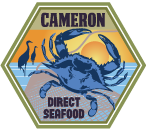Cameron Region
Fresh, local and wild caught seafood.
 It’s a natural in Louisiana’s Outback℠
It’s a natural in Louisiana’s Outback℠
Located in the southwest corner of Louisiana, Cameron has the most land area in Louisiana with a total of 1,932 square miles.
It is composed of a fertile and diverse landscape that includes lakes, rivers and bayous, prairies, wetlands, marshes, Gulf beaches and the unique cheniers—ridges of fertile higher land, often topped by live oak trees and farms, that were once beaches.
Not surprisingly, evidence of Cameron’s earliest inhabitants, the Attakapas, are found around the shores of Grand Lake and atop the cheniers—which provided fertile farmland and access to area rivers. Early American settlers from the east coast, mainly those of Anglo-Saxon and Celtic descent, migrated to the cheniers after the Spanish boundary line was placed at the Sabine River in 1819. The prairies in the northern part of the parish were settled later by the French of Louisiana, descendants of the displaced Acadians as well as French Creoles.
In this wonderland of untamed natural beauty, wildlife of every kind flourishes, including shrimp, crabs, oysters and fish.
Whether you catch it yourself or buy it straight from the fisherman, it’s always an adventure.
Taste the difference when it’s direct from the sea.
• • •
Since 1870.
The parish of Cameron was officially formed in 1870, and the years after the Civil War marked a time of growth and prosperity. Always susceptible to devastating hurricanes, the area was hit hard in 1886, 1915, 1918, and most severely by Hurricane Audrey in June of 1957 and Rita in 2005. The people of Cameron are known for an indomitable strength of spirit, rebuilding their lives and livelihood with the help of abundant natural resources including fish, game, fertile farmland and a wealth of oil and gas.
This pristine environment, which has provided for many generations of Cameron families, is also partially protected by three national wildlife refuges: Cameron Prairie, Lacassine and Sabine, and one State refuge: Rockefeller. Each seeks to preserve a specially treasured environment—from the ecologically important wetlands of the Sabine NWR to the coastal prairie and marsh of Cameron Prairie NWR. Home to a multitude of wildlife, Cameron Parish is known as a mecca of migrating birds due to its location along the Central and Mississippi Flyways.
You can access this natural splendor by way of the Creole Nature Trail All-American Road, better known as Louisiana’s Outback℠, and our fishermen are proud to call it home. The mission of CameronDirectSeafood.com is to provide a single portal for visitors to find, and buy, fresh, wild-caught seafood directly off the boat. Created in partnership with LSU Ag Center and Louisiana Sea Grant, the web site posts the ‘fresh catch’ messages from fishermen throughout the region; the public is urged to contact fishermen directly for location information and to place an order.

Sorry, no posts matched your criteria.

